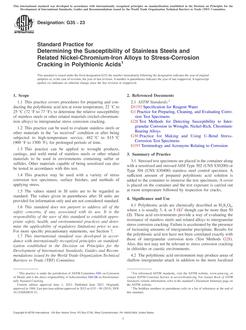
ASTM E637-98
1.1 This test method covers the calculation from heat transfer theory of the stagnation enthalpy from experimental measurements of the stagnation-point heat transfer and stagnation pressure.
1.2 Advantages:
1.2.1 A value of stagnation enthalpy can be obtained at the location in the stream where the model is tested. This value gives a consistent set of data, along with heat transfer and stagnation pressure, for ablation computations.
1.2.2 This computation of stagnation enthalpy does not require the measurement of any arc heater parameters.
1.3 Limitations and Considerations -There are many factors that may contribute to an error using this type of approach to calculate stagnation enthalpy, including:
1.3.1 Turbulence -The turbulence generated by adding energy to the stream may cause deviation from the laminar equilibrium heat transfer theory.
1.3.2 Equilibrium, Nonequilibrium, or Frozen State of Gas -The reaction rates and expansions may be such that the gas is far from thermodynamic equilibrium.
1.3.3 Noncatalytic Effects -The surface recombination rates and the characteristics of the metallic calorimeter may give a heat transfer deviation from the equilibrium theory.
1.3.4 Free Electric Currents -The arc-heated gas stream may have free electric currents that will contribute to measured experimental heat transfer rates.
1.3.5 Nonuniform Pressure Profile -A nonuniform pressure profile in the region of the stream at the point of the heat transfer measurement could distort the stagnation point velocity gradient.
1.3.6 Mach Number Effects -The nondimensional stagnation-point velocity gradient is a function of the Mach number. In addition, the Mach number is a function of enthalpy and pressure such that an iterative process is necessary.
1.3.7 Model Shape -The nondimensional stagnation-point velocity gradient is a function of model shape.
1.3.8 Radiation Effects -The hot gas stream may contribute a radiative component to the heat transfer rate.
1.3.9 Heat Transfer Rate Measurement -An error may be made in the heat transfer measurement (see Methods
1.3.10 Contamination -The electrode material may be of a large enough percentage of the mass flow rate to contribute to the heat transfer rate measurement.
1.4 This standard may involve hazardous materials, operations, and equipment. This standard does not purport to address all of the safety problems associated with its use. It is the responsibility of the user of this standard to establish appropriate safety and health practices and determine the applicability of regulatory limitations prior to use.
Product Details
- Published:
- 01/01/1998
- Number of Pages:
- 8
- File Size:
- 1 file , 520 KB

